
Are you dreaming of spending a vacation in a summery paradise filled with blue skies, turquoise waters, and fine white sand? Perhaps you’re itchy to try snorkeling around a beautiful coral reef? Now, you don’t have to travel far and wide, struggle with complicated routes, or break your bank account. These idyllic paradises are located in Panglao, Bohol at the center of the Philippines.
On a more personal note, Sweetie and I want to give our sweet daughter Alexa a graduation gift that is not monetary or material. Rather we want to give her a gift that constitutes knowledge, rich experiences, and an understanding of nature and culture.. Letting her experience a trip in Bohol was the way to go. We were also very happy that our close friend Aivy tagged along.
We took an 8-hour, slow and smooth overnight ferry ride from Cebu to Tagbilaran, Bohol. You see, the nice thing about taking a good ole’ slow ship in the Philippines is that you get to sleep in a real bed while fresh sea air blows around you. You wake up refreshed at your destination.
At the break of dawn, we arrived at the busy port of Tagbilaran.

We had a hearty breakfast and bought our packed lunch at Tagbilaran’s McDonalds; it was the only food establishment open at that time.
Now, supposedly, we were to ride a tricycle to go to Dao Terminal to catch a regular jeepney to Panglao Island. However, our friendly tricycle driver said that jeepneys to Panglao take a very long time to fill with passengers before they rumble down the road; at times, filling one takes two to three hours. That will definitely put us off our itinerary.
As an alternative, he offered to drive us all the way to Panglao at a very reasonable price. So, off we went!

We arrived at our accommodations quite early, around 7 AM. After checking in and changing to our rash guards, we were ready to start our exciting island hopping adventure. The owner of the bed-and-breakfast where we stayed in has already arranged the boatman to take us to the islands around Panglao.
Oh, look! They provided us a free shuttle!

In a few short minutes, we arrived at the next baranggay to meet our boatman. After exchanging pleasantries and aggreing to a minor change in our route, we started walking down a small pathway towards a sandy cove.
On the way, we saw interesting snippets of quiet country life such as this mother-and-daughter team. They were laying down freshly gutted fish to dry out in the sun. Lightly fried, salty dried fish is a common staple here in the Philippines. It is usually eaten with hot rice and dipped in vinegar with chilies.

Since it was still low tide, we need to trek across this nice sand flat to get to our boat. It is the home of thousands of moluscs and crabs that shorebirds pray upon.

Isn’t that a nice vessel? Wooden outrigger boats are ubiquitous in the Philippines and are amazing marine engineering feats in themselves. Their wooden hulls, which are resistant to rust, are very narrow, enabling the sleek vessel to slice through the waves. Balance is achieved through two hydrodynamically shaped outriggers jutting out on both sides of the hull.
The ingenious vessel draws very little water and floats high on the water, which makes it ideal for cruising around shallow reefs.

After maneuvering the boat to deeper water, our boatman started the vessel’s noisy engine. We were on our way to our first destination, and we sailed across Bohol’s lovely aquamarine waters.

Fish Pen
Spiky fish pens like these are common sight in Panglao’s waters. A large net is threaded along those numerous bamboo posts jutting out of the water. Numerous fish are then bred, grown, and nourished inside the pen. When they’re fully grown, the fish are then harvested and sold in the market.

Our friendly boatman first took us to our first destination, a small fish pen that also serves as a feeding station. For us, this is a great opportunity to check out how a fish pen works.

A rickety bamboo walkway allows guests to walk around the pen. At the center is small hut that serves as a shelter and a lookout for fishermen.
The tough green nylon net that holds hundreds of fish was clearly visible from this point. While the net imprisons the fish, it also protects them from predators.

Visitors can toss fortified pellets that provide food and nutrition for the fish. Yes, there was a feeding frenzy.

Isola di Francisco
After half an hour checking out each inch of the fish pen, we figured out that we’re ruining the fish’s diet. Hehehe! So, we left the fish pen and went to our next destination. The summery morning became brighter, and the sea became even lovelier.

We arrived at this amazingly pristine sandbar locally known as Virgin Island or Pongtod, which lies squarely on the Panglao Reef Flat. The floating buoys are there to demarcate the swimming areas. No boats are allowed to anchor inside the buoys.
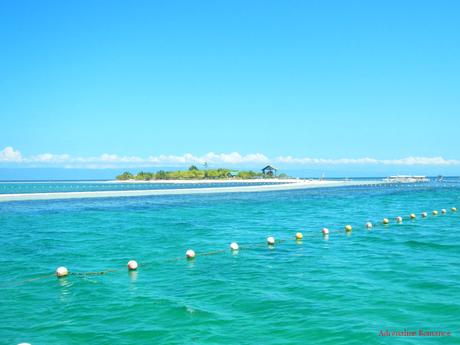
In fact, they have their own parking area while waiting for their guests to go back.

Welcome to the idyllic sandbar of Isola di Frenceso. Yes, entrance to the island was free of charge when we visited there. We do hope it stays that way. Or if fees are implemented, we do hope they’re affordable for everyone. There were also highly visible message boards that displays
Wait, we said this is Virgin Island, right? Well, it turned out that after Francescan friars bought this island recently, it was renamed Isola di Francesco, or Island of Saint Francis

Whoopee! Just check out that fine white sand and that turquoise water. Don’t you just want to bask in the sun or simply dive in?

But first, let’s explore this island; as we approached it, it definitely looked like it’s more than just a sandbar. At the north part of the island is a large golden statue of the Francescan friar St. Pio, who is known to exhibit signs of stigmata.

Bamboo lounge beds? Why not? If not for the garish paint, they would fit perfectly in the beach.

Before enjoying the island, it is best to get acquainted with a few rules. Yes, you are not allowed to kiss!

Let’s check out their mini museum and visitor’s center, which is made of native amakan, nipa, wood, and bamboo. They have a small “store” where you can get snacks, beverages, souvenirs, and trinkets. Now, there’s no price on the items! Yes, you guessed right: you don’t buy them. Instead, if you want to have something, you give a donation whether cash or in kind.
There is also a mini museum filled with photos of Francescan friars.
Disabled people and the elderly who wish to go around the island are given free access to wheelchairs.

Outside the mini-museum and the visitor’s center, we found a shady green grove that where guests can seek refuge from the sun’s heat. Seabirds, pigeons, and doves regularly visit the grove, and they don’t seem to mind those pesky humans coming a feet or two from where they’re perching.
Huge clay jars, colorful flower beds, and decorative bamboo fences adorn the grove.

Religious statues of angels, cherubs, and the Holy Family are laid out all over the shady grove. We later learned that Isola di Francesco, which is ownd by the Philippine Centre of St. Pio of Pietrelcina, is to be made into a pilgrimage center and a place of spiritual reflection.

Hired local workers toil under the sun to build a chapel, a few restrooms, water tanks, and guest houses in the island. Since Isola di Francesco is cut form the mainland, it needs to be relatively self-sufficient thus the construction of a water tower.
The island itself is maintained through gratuities.

It was getting hotter as the morning wore on. That meant, it was time to take a dip! Panglao’s crystalline water was an elixir to the skin.

Let’s go to the other side and check out that long, white sandbar. What a spectacular, summery sight! Certain parts of the sandbar become fully submerged during high tide.

What about a selfie on the way? Hehe! Check out that dazzling aquamarine lagoon.

Smile for the camera! Don’t you just want to stay all day in that clear, cool water?

After spending roughly two hours in this island paradise, it was time to leave to our next destination. But Aivy and Alexa can’t seem to get enough fun!
But let us share us a tip: do wear a pair of good-quality, UV-blocking sunglasses. The fine, powdery sand in Isola di Francesco is so white that it reflects harsh sunlight back to your eyes.

Gak-ang Island
After re-boarding our boat, we sailed towards Gak-ang Island, which is a relatively new destination in Panglao. Along the way, we passed by humble fishermen who were happily harvesting the bounty of the sea.

Less than half an hour, we arrived at an uninhabited and ordinary rocky islet. Yes, this is Gak-ang Island, and except for the long line of floating buoys, nothing seemed to be particularly extraordinary.

Well, the real gem of Gak-ang Island is not the island or something on the island (but we do believe it is a refuge of birds, snakes, and other reptiles) but under the tranquil waves that lap on the island’s shores. Gak-ang Island sits atop a small submerged shelf that is insanely rich with corals.
Yes, it’s a new snorkeler’s haven and a locally protected area.

The coral formations in Gak-ang Island are unique; they form almost uniform clumps. Inside the crevices of these wafer-like corals is a wide variety of fish, moluscs, shellfish, anemones, and other creatures.

But let’s talk about safety first. You need to be careful where you place your feet when snorkeling in Gak-ang Island because there are colonies upon colonies of black sea urchins. Those wicked spikes, which breaks easily upon contact, can easily puncture the skin of your feet. Punctures from sea urchin spikes are very, very painful.
That’s why we strongly advise that you wear a life vest or, if you know how to swim, hover above the corals to avoid these urchins. Never step on the delicate corals!

These small sea urchins have shorter spikes than those black ones. In other shorelines in the Philippines, kids and parents wade in the water during low tide to hunt these creatures. Their meat is quite delicious, and they can be eaten raw.
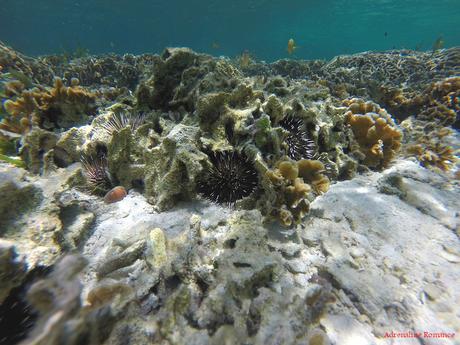
Oh, hello there, Marlin and Nemo! Many of the corals have become firm attachment points for dainty sea anemones, which serve as homes for gaily-colored clownfish.

A sea of stars—literally! Gak-ang Island has starfish of all kinds, shapes, and colors everywhere! That blue one with the short spikes is my favorite.

But not all sea stars are passive. We found several spiky crown-of-thorns starfish crawling around the reef. This species feed on corals. An unchecked infestation of crowns-of-thorns can decimate huge sections of a coral reef.
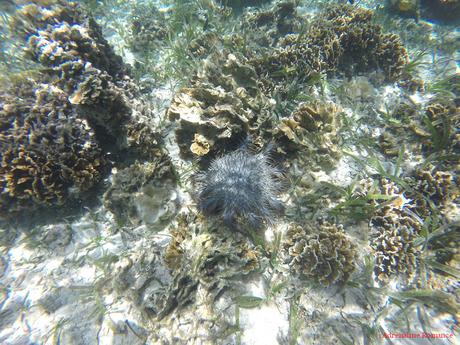
We also found the biggest crown-of-thorns we’ve ever seen in our entire adventuring lives! The body of that monster is about the diameter of an inflated full-sized basketball! And that’s still excluding the arms!
Those spikes are truly wicked, in fact, more so than those of those black sea urchins! They contain toxins that can cause excruciating pain for several hours. The toxins are also haemolytic, so a victim may experience continuous bleeding. It requires surgery to successfully remove spines that have been embedded in the skin.

We think you can safely say we thoroughly enjoyed our snorkeling adventure in Gak-ang Island.

An Afternoon Break
A little after noon, we were back in our bed-and-breakfast. It was searing hot, but we couldn’t resist eating our lunch out in their beautifully manicured garden.

Much to our surprise and delight, our accommodations has this really tiny swimming pool! Yes, there is a deep end and a shallow area, just like in bigger pools.
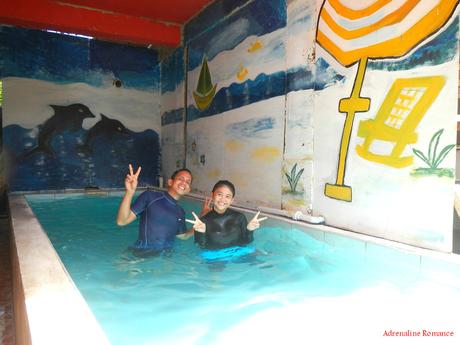
The ladies were quite exhausted after an entire morning of island hopping, swimming, and snorkeling. While they took a nap, I took the time to work on a few writing projects. This is what is nice bringing a netbook when traveling. Hehehe!

Alona Beach
At 5 PM, we went to the world-famous Alona Beach to check out the fiery sunset. With its white sands, fascinating dive sites, rich coral reefs, and enchanting scenery, it is not surprising why Alona Beach is considered as one of the most famous tourist attractions in Bohol.
Lining up the beach are numerous restaurants, hotels, stores, and more. While we understand that this is good for the local economy, it was a too commercialized for us.

There are also numerous dive centers in Alona Beach; just take your pick. They take divers to the equally numerous dive sites in Bohol, including the underwater kingdom in Balicasag Island.
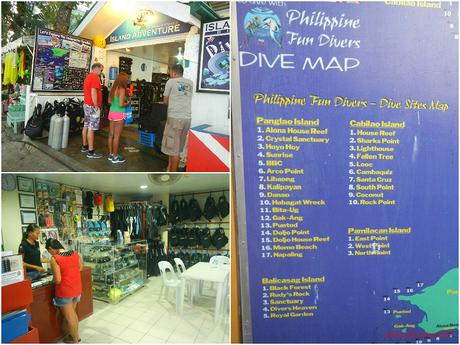
We found the restaurants in Alona Beach a little bit too much for our limited budget. So, we headed out to the town center and found this nice, humble restaurant that serves authentic Italian pizza and pasta at very reasonable prices. They even allowed us to buy a few bottles of Coke at a nearby sari-sari store; that saved us even more money!
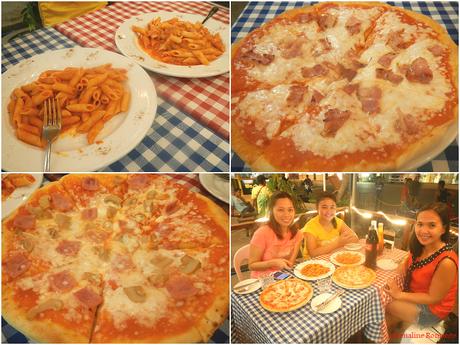
Soon, it was time to go back to the bed-and-breakfast to get ready for bed. We still have a long day the next day for a tour around the Bohol mainland.
Our island hopping experience in Bohol was thoroughly satisfying, and we enjoyed every bit of it. If a nearby paradise is what you are looking for, then Panglao and the majestic surrounding islands are the perfect places for you.
Tips to follow

